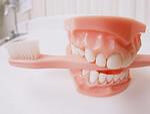The most complex diseases of the oral cavity start quite simply from gum inflammation and gingivitis. During several months the inflammation might be transformed into a periodontal disease and damage your teeth and health. In the worst cases, teeth are lost.
Periodontitis is an advanced stage of gingivitis. The inflammation will gradually pull gums from the teeth up forming spaces called pockets. These pockets become infected with bacteria, which causes the support structures around the teeth to get damaged due to infection. Bacteria forms a sticky plaque on teeth. This plaque is removed easily by brushing and flossing. If you don’t do that on regular basis the plaque will harden and form tartar that can be removed only by dentist. The main goal of treatment is to clean the bacteria from your teeth.
Symptoms of gum disease are:
- Bad breath
- Bleeding gums
- Red and sensitive gums
- Painful chewing
Any of these symptoms may be a sign of a serious problem.
Several methods are available
to treat periodontal disease depending on the severity.
Non Surgical Treatments
- Deep Cleaning (Scaling and Root Planing) in conjunction with a laser and prescription antibiotic is a treatment of choice for gum disease at its early stages. Scaling includes scraping off tartar and bacteria from the gum line. The rough spots on the root surface of the tooth are removed by root planing.
- When periodontal disease has progressed deep cleaning will no be enough. In this case you will need surgical treatment.
Surgical Treatments
There are two types of surgical treatment for periodontitis.
- Flap surgery is performed by a dentist to remove tartar in deep pockets by reflecting the gingival flap. The gums are then sutured back in place. Flap surgery is performed using local anesthesia and the surgery usually takes 1-2 hours to complete.
- Bone grafting is performed when the disease damages the bone around the root of the tooth. The graft is a small pieces of natural or synthetic bone. Bone grafting holds the tooth in place to prevent its loss.
- Guided tissue regeneration is a procedure when a special material is inserted between the bone and gum tissue. This procedure allows the bone and connective tissue to regenerate and heal.
How to avoid gums disease?
- Brush your teeth twice a day with fluoride toothpaste.
- Floss regularly to remove plaque from between teeth..
- Visit the dentist routinely for a check-up and professional cleaning.






